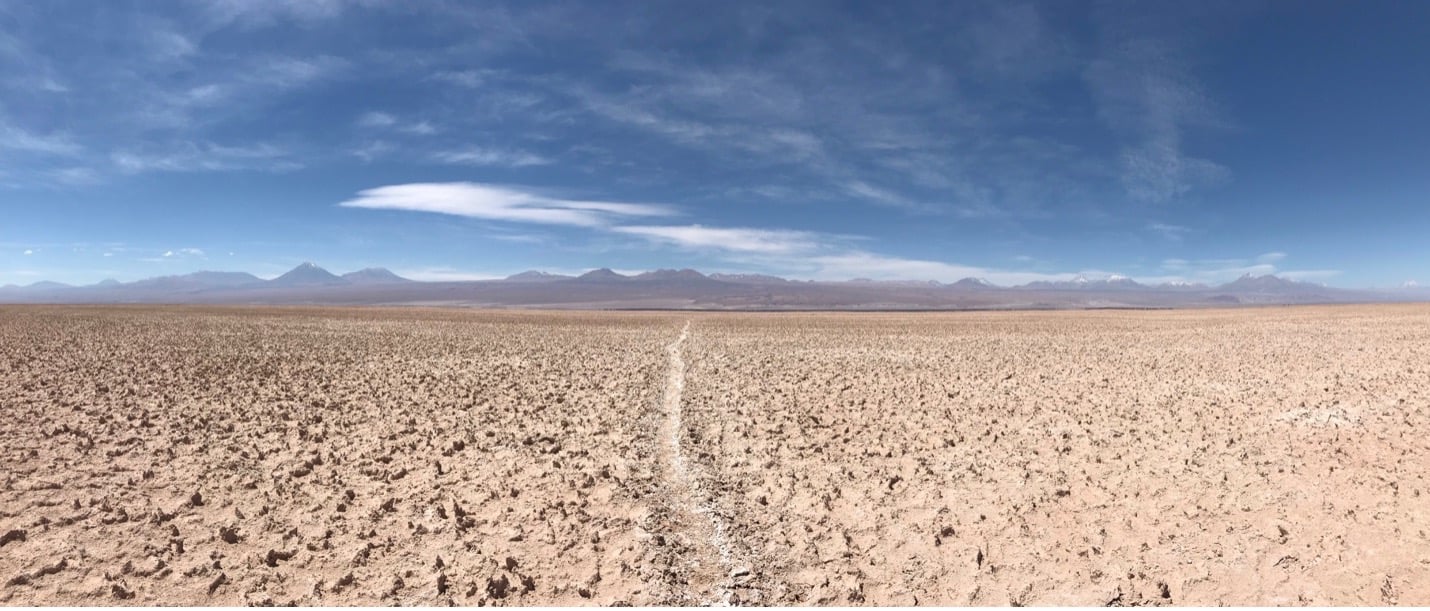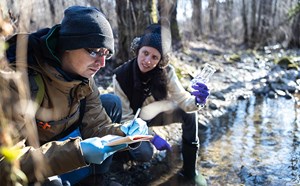
Strategies for Treating Heat Exhaustion in Remote Ultraendurance Races
Pictured above: Course through the exposed salt flats of the Atacama Desert, Chile
Dave Young, MD
Chair, ACEP Wilderness Medicine Section

As wilderness medicine professionals, we are typically familiar with the increasing popularity of ultraendurance sports. In fact, many of us have served competitors as medical staff on race day and may participate in these events ourselves. Many of these races not only are extreme in the distances they cover, but also in the terrain and climate. The original stage race, Marathon des Sables, takes place over 6 days (250 km) in the Sahara Desert of Morocco. Similar multi-day stage races take place in the Atacama Desert (Racing the Planet) and Arizona (Grand 2 Grand). The infamous Badwater Race starts at in California’s Death Valley each summer. This 135-mile race typically records temperatures in the 120s (49 degrees C).
It’s easy to see how these long events in remote and hot places can pose health risks to competitors. Last year, Dr. Prendergast wrote a piece for this newsletter reporting on an extremely hot multi-stage ultra-race in the Namib Desert (refer to this article on the Wilderness Medicine Section website). Having worked about 10 of these races (a couple alongside Dr. Prendergast), I’d like to offer this follow-up article about practical ways to help athletes suffering from heat illness in an effort to get them back racing and ultimately across the finish line.
Recognizing the symptoms of heat exhaustion is the obvious first step to being able to manage these patients. Not surprisingly, the most common symptom is feeling hot or overheated, followed by fatigue. Athletes often feel dizzy and lightheaded. Sweating is common, which may lead to significant dehydration. Because blood is typically shunted to the muscles to perform exercise and to the skin to help increase heat loss, little blood perfuses the gut, leading to nausea and bloating. When this occurs, competitors often struggle to keep up with oral intake to match significant volume losses as sweat1. Later complications can include severe dehydration and decreased renal output, causing an acute kidney injury. On the severe end of the heat illness spectrum is heat stroke, characterized by a temperature above 104 degrees F (40 degrees C), ataxia, confusion, and seizures2.
For most athletes with heat illness, they will report feeling hot, fatigued, and nauseated. I have encountered many athletes who plop down at the aid station feeling so horrible they feel they simply cannot continue. Quickly cooling these competitors is essential. I start by placing them in the shade, taking their packs and hats off, and using a spray bottle to wet their skin and clothes. Because of the dry air in the desert, the evaporation is rapid with a breeze/fanning and provides the best cooling when ice packs or air conditioning isn’t present. If lucky enough to be close to a body of water like a lake or river, submersion in water is quite effective as well – just be careful you’re not exposing this patient to risk if they happen to be confused or weak. While I don’t usually have cool fluids, sipping any fluids is beneficial if they can tolerate it. If nausea is too severe, ondansetron (4 mg ODT every 6 hours) is handy to have. Intravenous fluids may be warranted, depending on ability to tolerate oral fluids and hydration status. Rest is another key component to cooling, as the athlete won’t be exerting or producing an internal source of heat.
While heat illness may ultimately be the cause for many athletes not to be able to finish, I have found that these tactics above have surprised even the most despondent, as they typically feel significantly better in 10–20 minutes. Once feeling better, I am sure to ask them about hydration, nutrition, and frequency of urination. Even if the athlete is feeling improved and wishes to continue, heat illness can lead to dangerous life risks and these participants should be closely monitored and during the course of their race.
Recognizing heat exhaustion and treating it rapidly can have a drastic impact on an athlete’s race and overall well-being. Please let me know if you have other techniques that have worked well for you when I see you at our next ACEP meeting.
- Gaskell SK, Burgell R, Wiklendt L, Dinning P, Costa RJ. Does exertional heat stress impact gastrointestinal function and symptoms? Journal of Science and Medicine in Sport. Volume 25, Issue 12. 2022. Pages 960-967.
- Noakes TD. A modern classification of the exercise-related heat illnesses. Journal of Science and Medicine in Sport. Volume 11, Issue 1. 2008. Pages 33-39.



